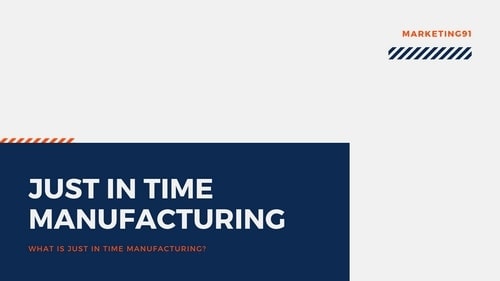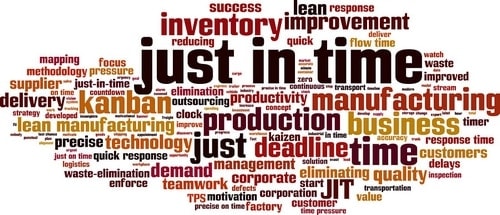Just in Time Manufacturing is also known as just-in-time production or the Toyota Production System and can be defined as the methodology with an objective to reduce times within the manufacturing system as well as response times from suppliers and to the targeted customers.
Just in Time Manufacturing concept is a management philosophy and not just another technique. It was originally referred to the manufacturing of goods to meet the demands of the customers exactly in time quality, and quantity, whether the customer is the final purchaser of the product or another process further along the production line of the company.
It has now come to mean production with minimum amount of waste during the manufacturing process. Waste is taken in its most general sense and includes time and resources along with the raw materials and inventories.
Table of Contents
Just in Time Manufacturing – Background and History
Just in Time Manufacturing is a Japanese management philosophy which has been applied in practice since the early years of the 1970s in the various Japanese manufacturing organizations.
The concept was first developed and perfected within the Toyota manufacturing plants by Taiichi Ohno as a means of meeting customer demands with minimum delays possible. Taiichi Ohno also very frequently referred to as the father of JIT.
The automobile giant Toyota was able to meet the increasing challenges of the market for survival through an approach that focused on people, plants, and the manufacturing systems.
Toyota realized that the concept will only be successful if every individual within the company was involved and committed to it and if the plant and processes were arranged for maximum output and efficiency of the products, and if quality and production programs were scheduled to meet the exact demands of the market.
Just in Time Manufacturing has the capacity if properly adopted by the organization, to strengthen the organization’s competitiveness in the market and substantially by reducing wastes and improving the overall product quality and efficiency of production techniques.
There are various strong cultural aspects associated with the surfacing of JIT in the country of Japan. The Japanese work ethics involves the below concepts:
Workers are highly motivated to seek constant improvement in the production processes that which already exists. Although high standards are currently being met, there exist even higher standards to achieve within the organization.
Companies focus on the overall group effort which involves the combination of talents and sharing knowledge, problem-solving skills, ideas, and the achievement of the common goals and virtues.
Work itself takes precedence over leisure in the approach. It is not unusual for a Japanese employee to work 14-hours a day on a consistent basis.
Employees tend to remain with one company throughout the course of their career span and it allows the opportunity for them to polish their skills and expertise at a constant rate while offering numerous benefits to the company as well.
Elements of Just in Time Manufacturing :
Continuous improvement in the processes
Attacking fundamental problems that do not add value to the final product.
Devising systems to identify potential problems.
Striving for simplicity as simpler systems are easier to understand, easier to manage, and less likely to go wrong in nature.
A product-oriented layout that produces less time spent moving of materials and the required manufacturing parts.
Quality control at source as each worker is responsible for the quality of their own output during the entire process.
Poka-yoke that signifies the foolproof tools, methods, jigs etc to prevent mistakes
Preventative maintenance and Total productive maintenance to ensure machinery and equipment functions perfectly when it is required, and continually improving the process.
Eliminating the seven types of waste:
- Waste from the overproduction of goods
- Waste of waiting time.
- Waste of transportation.
- Processing and manufacturing waste.
- Inventory waste.
- Waste of motion.
- Waste from the product defects.
Some more steps in Just in Time Manufacturing are
- Good housekeeping that signifies workplace cleanliness and the overall organization.
- Set-up time reduction that increases flexibility and allows smaller product batches. Ideal batch size is 1item.
- Multi-process handling is a multi-skilled workforce that generates greater productivity levels, flexibility, and job satisfaction.
- Leveled and mixed production that smoothens the flow of products through the entire factory.
- Kanban simple tools to pull products and components through the manufacturing process.
- Jidoka (Autonomation) that provides the machines with the autonomous capability to use judgment so that the workers can do more useful things than standing and watching them work.
- Andon (trouble lights) that helps to signal problems to initiate the corrective action.
Benefits of Just in Time Manufacturing :
When done well in the organization, adopting the concept of Just in Time Manufacturing system can have a drastic and fruitful impact on an organization’s productivity, risk management, and operating costs. Below mentioned are a few of the quantitative benefits experienced by the various manufacturers worldwide:
- Reduction in the product inventory costs
- Considerable reduction in labor costs
- Reduction in space required to operate
- Reduction in the work in process
- Increase in the production levels
- Improvements in quality of the product and lower rates of defects
- Reduction of overall throughput time
- Reduction of standard hours of production
- Increase in the number of shipments of goods
Potential Risks of Just in Time Manufacturing :
- In general, companies adopting the Just in Time Manufacturing practices enjoy the benefits of reduced production cycle times, faster delivery times to market, and reduced operating costs but there are some potential risks, especially for smaller companies.
- In order to find success with the overall process, it is very important to find suppliers that are close by to the company location, or that can supply materials quickly with limited advance notice as and when required.
- Sometimes, minimum material order policies can pose a risk to smaller manufacturers who might order smaller quantities for the required materials.
How does Just in Time Manufacturing differ from traditional manufacturing?
- In traditional manufacturing concepts, we try to predict what the customer in the operation will require and we will create a forecast against which we will produce our products.
- We will also try to produce those products in a large number of batches as the belief is that will make machines and processes more efficient and effective, especially if those machines require a longer time to set up.
- This will typically result in longer lead times through the overall processes, huge amounts of Work in Process stocks and also large quantities of finished goods stocks that have not yet been ordered by our customers and are lying unused.
- If the customer does order something that is not in the current stocks of the company they will either have to wait for many weeks or even months for the product to be manufactured or work will be hurried through the system by progress chasers causing a huge amount of disruption to the entire manufacturing schedule.
- These systems are usually run by Manufacturing Resource Planning programs that will try to schedule each and every process within the production facility of the firm.
- These software packages will seek to control each and every step and everything requires careful, intricate, and complex planning.
- The Just in Time Manufacturing system, on the other hand, will seek to use simple visual tools and methods such as Kanbans to pull production through the various processes according to what the customer actually requires.
- It massively reduces the amount of stock held in the warehouse and will reduce lead times by a significant amount, often from weeks to a few hours or days.
Liked this post? Check out the complete series on Operations Management

